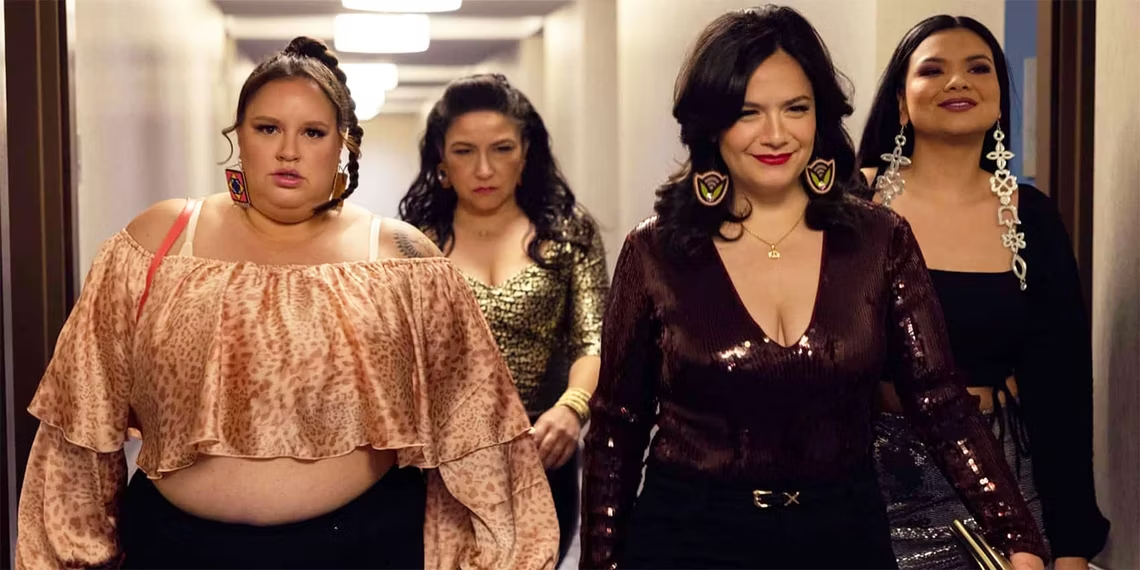
- Details
- By Native News Online Staff
Co-created by Indigenous filmmakers Sterlin Harjo (Seminole) and Taika Waititi (Māori), the coming-of-age drama/comedy follows the lives of four Native American teens — played by’ Pharaoh Woon-A-Tai, Devery Jacobs, Paulina Alexis and Lane Factor — growing up on an Oklahoma reservation. The show debuted in 2021 to immediate critical acclaim.
The first two seasons of “Reservation Dogs” takes viewers on a journey with the teenage characters who are grieving the death of their best friend and promising to fulfill his dream of traveling to California. The show — which has an all-Indigenous writer’s room, crew and regular cast — has received wide praise for its nuanced portrayal of modern Native life and has netted numerous awards, including a 2022 Peabody Award and a 2022 Independent Spirit Award. The show has a 99% rating on the popular movie and television review website Rotten Tomatoes, making it one of the website’s top-rated shows of all time.
“It’s nothing like I’ve ever seen or felt before,” said Danger, who is a member of the Muscogee and Seminole nations. “We are so often seen as historical relics. To see us in a modern setting, dealing with real problems – but also rez problems – was so refreshing and says, ‘We are here. And we are going to be represented.’”
Season two, which premiered on Sep. 28, 2022, featured cameos by several well-known Native Americans, including former U.S. Poet Laureate Joy Harjo, award-winning actor and comic Tatanka Means, and “Prey” actress Amber Midthunder.
In an interview with GQ Magazine in 2022, Harjo was asked how he felt about the show — embraced by both audiences and critics — being passed over for an Emmy.
“The fact that I get to tell this story and it’s supported and we’re on Season 3, I mean, that’s better than any Emmy,” Harjo replied. “The fact that Native people have something they’re so proud of and take ownership of is better than any Emmy.”
More Stories Like This
First Tribally Owned Gallery in Tulsa Debuts ‘Mvskokvlke: Road of Strength’Zuni Youth Enrichment Project and Partners at Ho’n A:wan Productions Launch 8th Annual Delapna:we Project
Chickasaw Holiday Art Market Returns to Sulphur on Dec. 6
Center for Native Futures Hosts Third Mound Summit on Contemporary Native Arts
Filmmakers Defend ‘You’re No Indian’ After Demand to Halt Screenings
Help us defend tribal sovereignty.
At Native News Online, our mission is rooted in telling the stories that strengthen sovereignty and uplift Indigenous voices — not just at year’s end, but every single day.
Because of your generosity last year, we were able to keep our reporters on the ground in tribal communities, at national gatherings and in the halls of Congress — covering the issues that matter most to Indian Country: sovereignty, culture, education, health and economic opportunity.
That support sustained us through a tough year in 2025. Now, as we look to the year ahead, we need your help right now to ensure warrior journalism remains strong — reporting that defends tribal sovereignty, amplifies Native truth, and holds power accountable.
 The stakes couldn't be higher. Your support keeps Native voices heard, Native stories told and Native sovereignty defended.
The stakes couldn't be higher. Your support keeps Native voices heard, Native stories told and Native sovereignty defended.
Stand with Warrior Journalism today.
Levi Rickert (Potawatomi), Editor & Publisher


